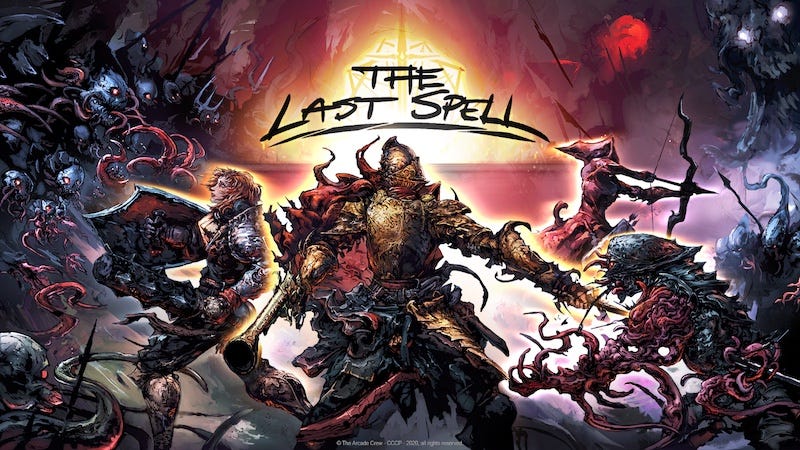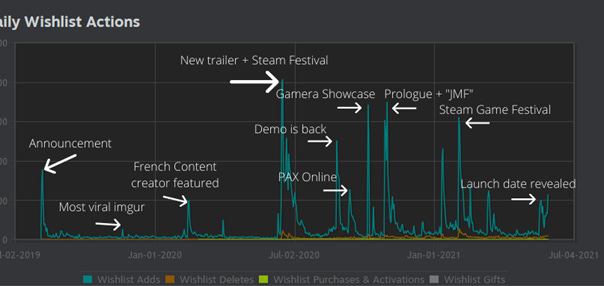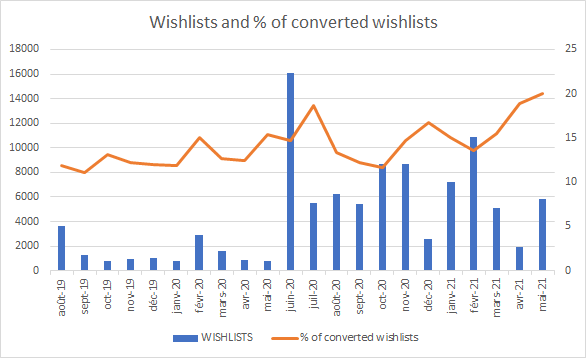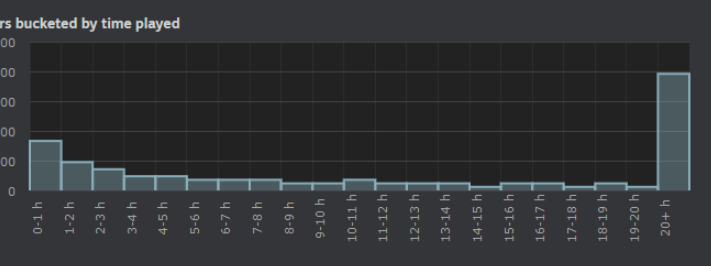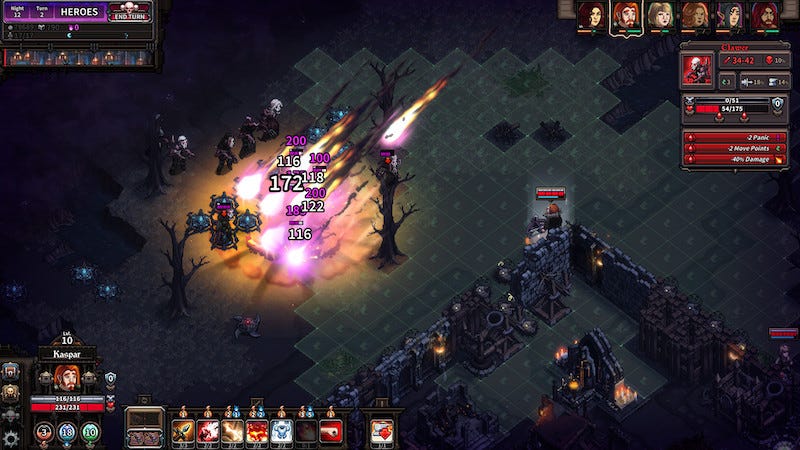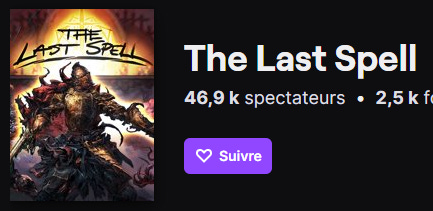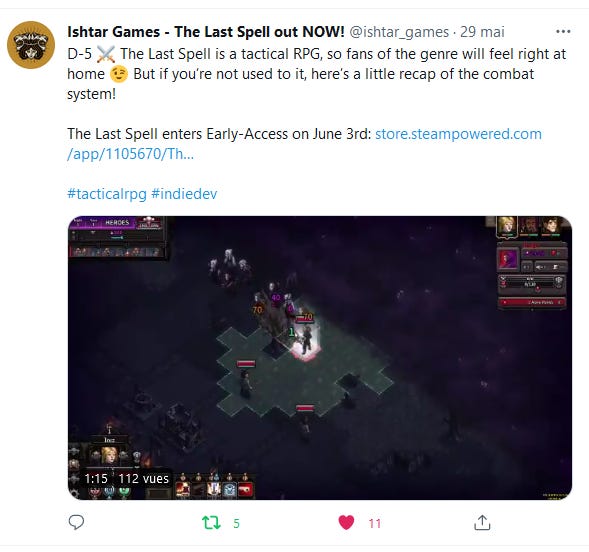The Last Spell: how we surprised ourselves & sold 130,000 units
Publikováno: 2.8.2021
...in the first 2 months, that is.
[The GameDiscoverCo game discovery newsletter is (normally) written by ‘how people find your game’ expert & GameDiscoverCo founder Simon Carless, and is a regular look at how people discover and buy video games in the 2020s. This time, we’re delighted to have a special guest writer - Bruno Laverny of Ishtar Games, who’s going to talk about his studio’s recent Steam success, and what devs can hopefully learn from it. Take it away, Bruno…]
First of all, hello! My name is Bruno Laverny, I’m the Marketing Director for the indie studio Ishtar Games. We previously released the games Dead in Bermuda and Dead in Vinland.
Last month, we released another game that you might be familiar with: The Last Spell.
The Last Spell has been out for two months now, and I thought it would be the perfect moment to do a small post-mortem of the marketing around it, since it sold way above our expectations.
(Disclaimer: none of what I’m about to say is exact science. This means that there may be things that worked for us and won’t work for you, and the other way around. However, I feel that there are certainly things that other devs might find useful.)
The game
First, the game. The Last Spell is a tactical RPG with roguelite elements. It entered Early Access on June 3rd, 2021 on Steam, and is currently available in English, French, plus Traditional and Simplified Chinese. Basically, you need to protect your city and kill hordes of monsters so your mages can cast “The Last Spell” (roll credits).
When we started to talk about the game, it was supposed to be a “little” thing that we would do between two “Dead in” games (lol). Anyway, I won’t talk about the story of the making of the game, but basically the scope got WAY bigger than anticipated. Also, we got a super cool publisher on board with us: The Arcade Crew!
We announced the game in August 2019, and released it nearly 2 years later in June 2021. Right now, the game has been out for nearly two months, and it sold way above our expectations: over 130,000 units were sold, which is BIG for us!
The Marketing Plan
When we announced the game, we thought it was going to come out in Q1 2020… Yeah.
As I stated above, the game got way more ambitious than we first thought, so the development took more time. Now that the game is out, I’ll go over the different steps:
The main timeline
August 2019 : Announcement + Gamescom
June 2020 : Partner Trailer + Steam Game Festival
July 2020 : “The Last Haven” Discord mini-game
September 2020 : PAX Online
October 2020 : Gamera (Publisher in China) Showcase + “Jeux Made in France” + Release of the “Prologue”
February 2021 : Steam Game Festival
May 2021 : Early Access Date Reveal + Closed Beta
June 2021 : Early-Access Launch
Our marketing channels
Since we had a strong publisher with us, we could afford to have a good social media presence:
Our objectives
Wishlists! Surprising, right? Actually, it’s not JUST wishlists that we were trying to get.
For The Last Spell, Early Access had been in our plans for quite a while. So, very early in production, we knew that the community would be heavily involved in the game. This means that very early in production, we wanted to not only have wishlists, but a community that would be there with us all along the game development.
This is why we wanted to be transparent with the community. And this is where things got hard, at some point, but I’ll expand upon that point later.
Wishlists + sales!
I know that’s why some of you are even reading that blogpost, so let’s do it!
A few stats before:
When we announced The Last Spell in August 2019, we nearly got 2,000 wishlists in the first three days
As we did more announcements, we gathered more wishlists
When The Last Spell was launched, we nearly had 100,000 wishlists (95k, to be precise!)
About 15% of the pre-release wishlists got converted into sales during the first month after release (plus a bunch more organic sales).
I tried to remember/explain how most big “spikes” happened and annotated the wishlist graph. I won’t go into details for each of those spikes, because that would take a while. However, I want to point out that anytime you have a game that can be featured on Steam, via an event or via a Steam Festival, it’s a HUGE opportunity for a game to gather precious wishlists. If you want more details, please feel free to ask me on Twitter ;)
Now, this is where things get tricky. There are many theories online about the worth of each wishlist. One of those theories is that the wishlists acquired via an event (a Steam Game Festival, for example) will convert less than the “natural”/organic wishlists.
For The Last Spell, this was not necessarily true. We saw an average of 15% converted wishlists, for the “empty” months AND for the “big” months. This basically means that every 6–7 wishlists added, 1 of them would be converted into sales. I was actually surprised to see this data! I was expecting the % to go very low during the Steam festival, and it didnt!
My theory: it’s a little hard to “explain” per se why this happened. My theory is that the Steam Page showed exactly what the game would be about. Also, when people wishlisted the game during a Steam Game Festival/NextFest, they weren’t doing it “out of curiosity”, they actually wanted to hear more about the game! (Also, we had very good daily ‘organic’ wishlists anyhow.)
We also saw a rise of this % as we got closer to the release date. This was actually good news, but easy to explain. People who added the game to their wishlist very “late” still knew about the game when it released a couple of days after wishlisting it.
Why did the game sell so well?
That’s the million dollar question. Thanks to a lot of stars being aligned (good concept, good art direction, good timing), I think the launch went great. There are probably a LOT of reasons why it sold so well - way above our expectations.
One interesting point is the content. Although there are players who don’t like the grinding in the game, a majority of our players do. This doesn’t mean that the game is perfect in any way - we still have a LOT of work to do about the balancing in general. But that’s a game design question ;).
It does mean that players tend to play the game a LOT. The median play time for The Last Spell is more than 10 hours.
Also, this means that streamers who love the game tend to return to it quite a lot, since there are many ways they can start over: new strategies, new unlocks, new weapons, new buildings…
The game does have a lot of potential in terms of replayability. (You should check out our Discord server and see how people are now making spreadsheets O.O that’s crazy)
One other reason why it sold so well is that the concept is simple to explain. Within one screenshot, you can already understand a LOT of how the game works:
In one screenshot, you can see that:
It’s a tactical RPG.
There are hordes of enemies.
Big AOEs (areas of effect).
There seems to be a city to protect.
Many stats/UI elements that tactical RPG fans LOVE.
This means that any time a player sees one screenshot, they don’t really need to know more info about the game - since everything they need is already in there.
The description of the game is also quite simple but effective: “A tactical RPG with roguelite elements where you must defend the last bastion of humanity against hordes of enemies.”
The concept is familiar enough for T-RPG fans to recognize they are interested in the game, but there is one twist that lets them know “This is not something I’ve already played before”. This also means that it’s very easy for them to talk about the game to their friends and favourite streamers for example: “Hey have you heard about The Last Spell? It’s like FF Tactics but as a roguelite, with hordes of enemies!”. Fun fact: when we started pitching the game to press and business partners, we talked about it as a “mix between Fire Emblem and Dynasty Warriors”!
One good thing about the game is that although it’s a VERY known genre, we’re different enough from our competitors. This means that people will less tend to compare The Last Spell with another one! (We were compared to They Are Billions, but it’s different enough not to suffer from the 1 to 1 comparison). By not trying to do “something LIKE” FF Tactics or Fire Emblem, people didn’t compare The Last Spell to them.
Because yeah, as indies, it’s very easy to say “Alright, I’ll make my game like X but EVEN BETTER”. Although some games did exceptionally well (looking at you, Hollow Knight!), it’s very hard to be better than your references, because of two reasons:
You probably don’t have the budget to do it
Even if you make one “good” game that can compare to your references, people will tend to say that the “original game” is better anyway.
So yeah, the big takeaway is that you need to make a game that’s easily recognizable, that players will want to try, but that’s not trying to mimic one big famous reference. Oh, and you should choose a viable genre. Easy, right?
What worked for us?
Steam featured events/Demos
We were lucky enough to take part in TWO Steam Game Festivals! That was because the first Festival didn’t have much requirements in terms of release date, if I remember correctly. (Now, when you want to apply to a Next Fest, it’s better to have a release date less than 6 month after that festival).
During those Festivals, we organized some streams, Q&As with the players…
I do have numbers for the first Steam Game Festival that you can see here! But the tl;dr version is that it brought us a LOT of wishlists, and as an indie dev, you want to have a good demo, because that will bring you quite a lot of wishlists. Being featured via Steam is very rare and hard to obtain. So, when you can get a feature via such an event, you don’t want to miss that chance. Make a good demo! Make sure players will have fun and want to play MORE of your game!
Discord mini-game
When you have a game that takes a while to be released, you want to keep your community active. Our idea was to create a “small” (lol) Discord mini-game called “The Last Haven”.
The basic idea was to create a mini-RPG that included some of the lore of The Last Spell with some multiplayer elements… It was not easy x) But in the end, our Discord server gained quite a lot of interactions thanks to people strategizing, playing together.
It was not a HUGE thing - I believe we had about 100 people in the end playing this game. They still ended up breaking our Discord bot many times, but they had fun, and it created a small sense of community.
Showing off the art of the game
As I said earlier, the pixel art of the game is appealing to players. They will think about Final Fantasy Tactics when seeing a screenshot, for example.
Although it didn’t have a huge reach on social media (more on that later), players loved seeing the pixel-art animations during the #screenshotsaturday for example. One good thing about The Last Spell is that there are a LOT of skills to show off, with really cool animations for each one of them.
The press
Alright, this one can be a bit controversial, because there’s no “real theory” when it comes to the effect of the press in terms of sales. It’s pretty much impossible to say “Ah we got a nice article in this one big outlet, and it drove us thousands of sales” (if it happened to anyone out there, please let me know, I’d love to be wrong on that one!).
However, what is important to keep in mind is that when it comes to marketing, there’s something called “Marketing Rule of 7”. Basically, it means that before buying a product (games included), someone needs to hear about it 7 times. Please note that this is NOT exact science. There are games that I will buy in a heartbeat after just seeing one trailer, and there are others that I hear about 20 times before i’ll even consider getting. What is important to keep in mind is that on average, someone will need to hear about your game several times before buying it.
But how can that apply to games? This means that some players will need to hear about your game several times before considering to buy it. And this is where the press is super useful.
Alright, let’s take an example. Imagine that you have a very nice trailer for your game. You’ve put a LOT of work into it, it has a great flow, it’s not too long nor too short, and it perfectly shows the player how fun your game is going to be. All you need to do is display it on social media, and you’ll have tens of thousands of wishlists in a heartbeat, right?
Unfortunately, this is very unlikely to happen. (Not impossible though! A game like Hollow Knight Silksong has that power of already being super popular, but that’s because the first game was a mega hit.)
It’s very likely that players will see your trailer on their timeline and say “ah that’s cool” and will forget about it 2 hours later. However, if they see coverage from your game in their favourite gaming websites, two or three times in the same week, they will likely think “Hmm, maybe I’ll check it out”
In my opinion (I may be wrong though!), you can’t base your entire marketing plan on the press. However, when you get nice coverage, it’s super helpful for you, because they will reach players that will say “Ah I see that game is popular, maybe I’ll see what this is about”.
As for The Last Spell, we got quite a lot of nice coverage from the press. During the announcement, we got articles from Gematsu, IGN, Kotaku, Gamekult, RPGSite, Jeuxvideo.com,… Basically, we were very happy with the announcement. This also means that there were a lot of coverage from the press during the announcement. This also meant that for each update about the game, there were editors interested in the game that were able to write about it later.
What you need to keep in mind though is that for early-access games, you won’t get “real” reviews when you enter Early Access. This means that you won’t get any Metacritic number before you leave Early Access.
Content Creators
Content creators have been nothing but extraordinary for The Last Spell. During the release timeframe, we got VERY popular on Twitch…
That definitely brought us a lot of new players (some came to our Discord server saying “I got the game after watching the stream from…”).
Also, our type of game is definitely streamer-friendly (although we don’t have a proper “streamer mode” in the game!), because streamers can start over their game as many times as they want, without feeling they’re just making the same content over and over again.
Thanks to the many possibilities in the game (strategies, traits, weapons, buildings…), players could give the streamers some advice about the game. This is also what kept the discord server alive: people sharing and theorizing their strategies about the game.
However, what I wrote above for the press also counts for streamers. It’s pretty much impossible to know “which streamer had which effect on your sales”. And that’s okay. As much as we marketing people would like to know the ROI of everything that happens, we just can’t.
One other interesting thing that can happen is that streamers know each other. They see what their streamer-friends are playing. So, if someone is playing your game, then their friends will maybe say “Ah this one looks cool, maybe i’ll get it for my community as well”.
What didn’t work for us
Social media
Alright, that may seem to be a weird one, because it’s not like our social media accounts are “dead”. Thanks to the release of the Last Spell, we now have over 7,000 followers on Twitter. However, most of our Twitter posts did quite poorly. Here’s one post that we did just before release:
As you can see, those ones barely got more than a few retweets and likes. To tell you the truth, it was a litte worrying for us, because we couldn’t see any “hype” around the game on social media, just weeks (and even DAYS) before the release!
Now, it’s important for us to figure out WHY it was so hard to get traction on Twitter with The Last Spell. I have a couple of theories, but I’ll be MORE than happy to read yours!
Our players who wishlisted the game weren’t necessarily on Twitter. They mostly were on Discord and Steam.
Although our skill GIFs looked great and worked for a while, maybe our followers got bored of them, eventually?
Along the same lines, maybe players knew about the game, and mostly needed info about the game? (More on that later!)
We should have made better posts, by engaging more with the community.
I don’t have a definitive answer to that, it’s probably a mix of those four reasons. But here’s what I’d change if I were to do it all over again:
More posts about the gameplay in itself, instead of focusing on “Ahah that skill looks fun”
More posts telling people they WILL enjoy the game
More blogposts about the game and its making
HOWEVER, there’s one thing that I need to point out which others have joked about. As you can see, we didn’t have a lot of reach on social media, and we still did well. At the same time, you’ll probably see some other indie games get a lot of RT/likes… mostly by other indie devs.
Even though it’s always good to have some love and support from other indie devs (and they will even give you some valuable feedback!!), this can create a false sense of safety when it comes to marketing.
Other indie devs are not your target audience. You need to show your game to your actual target audience, who can be on Steam, Reddit, Imgur, during events… Sure, it’s always nice to have some #screenshotsaturday traction, but if your game mostly gets seen by other indie devs, then you’ll stay in a filter bubble, and will most likely fail.
A LONG period of nothing
This was probably the one thing I would do differently. When we announced The Last Spell in August 2019, we had a release date for Q1 2020.. and, we released on June 3rd, 2021.
Anyway, this “delay” (it was not an official delay since we didn’t have a “true” announced official release date) was quite bothersome in terms of communication.
We had 17 dev blogs on our website, which can sound like a lot. However, for nearly 6 months (between the end of 2020 and May 2021), we didn’t post any blog updates..
This was due to many reasons - but the main one was that we were torn apart between “We want to tell the players everything, even if that’s spoiler territory!” and “We want to keep a lot of surprises for the release!”. Unfortunately, we struggled a lot with that and in the end, we ended up not writing any blogpost for 6 months. In my opinion, that was our biggest mistake in terms of communication with the players!
However, in April, we were starting to see more and more players on Steam wondering if the development was abandoned, even though we kept on updating the players on Discord.
One player even (rightfully!) said that as indies, we should be more transparent with the players. So, although that decision to keep things under wrap made sense back then, we realized that we should have kept them aware. For example:
Blogposts telling players what we were working on, by showing the latest improvements on the game
Our intentions and questions on the game’s development in general
Anyway, I think it’s better for players to know that the devs are working hard on the game they’re so excited about :)
Once again, this is what I believe, and this definitely doesn’t apply to every game out there (and also, writing blogposts take a LOT of time!)
Conclusion
Guess this post turned into a postmortem in the end. However, this may be closer to a “mid-mortem”, since we’re still in the Early Access period, so maybe all those thoughts and conclusions will change over time!
In the meantime, here’s a tl;dr of everything I wrote above :)
We’ve now sold more than 130k units in less than 2 months, which was way more than we anticipated.
Thanks to a simple but efficient concept, the game was very easy to market, especially to the target audience (fans of tactical RPGs + fans of roguelites).
It’s very important to know WHAT and WHERE your target audience is. It’s also important to know what your target audience wants. Do they want to see that your game is pretty?
We showed our game in as many online events as possible. Being featured by Steam is a crucial marketing beats.
The “Steam-boosted’ wishlists converted as well as the organic wishlists for us
Be transparent with your community. Even if you don’t have a big internet-breaking announcement, they need to know you care about them. As indies, we have an opportunity to be transparent with them so we might as well enjoy it ;)
Twitter wasn’t as effective as we wished it to be.
Discord mini-games are great for your community, but they take a lot of time. And players will probably end up breaking it T.T
If people don’t talk about your game pre-release, it doesn’t necessarily mean you’re going to fail. We had this big contrast between “great wishlist numbers” and “not many mentions on social media”. This is fine!
You need to make sure you’re in the “Popular Upcoming” on Steam.
Steam features were crucial for us.
Our game creates conversations, because of the different strategies/meta/weapons, etc… Thanks to that, many streamers and players constantly talked about it, and led to a lot of conversations on Discord, for instance!
[NOTE FROM SIMON: Thanks so much to Bruno for letting us reprint this! We’ll be back Wednesday for a full round-up of game discovery and platform news. And to keep supporting us and get our ‘Complete Game Discovery Toolkit’ eBook & lots more, sign up for GameDiscoverCo Plus newsletter now.]
